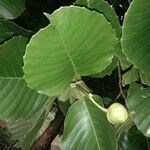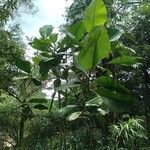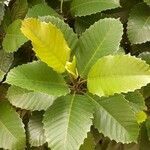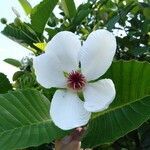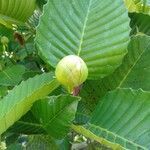Tree, up to 17 m high, 60 cm diam., with rather low-attached crown, reddish bark, and dark wood. Leaves elliptic or ovate to lanceolate, ca 10-15-nerved, 8-25 by 6-16 cm, chartaceous, with rounded to obtuse, often slightly acuminate apex, rounded to obtuse base, and slightly dentate or undulate margin. Petiole 3½-5 cm long, with half-elliptic to half-oblong, 3-12 mm broad, caducous wings. Inflorescence a 1-2-, rarely 3-flowered raceme with 5-16 cm long axis. Flower ca 10-15 cm diam. Sepals 5, the two outer ones ca 1.8 by 1.8 cm, the 3 inner ones 2-2½ by 1.7-2 cm. Petals white, 4-7 by 2-5 cm. Stamens in 2 distinct groups, the outer ones, ca 230, yellow, 11 mm long, straight in bud, the inner ones, ca 40, purplish, 15-23 mm long, with their apex reflexed in bud. Carpels 10-12, 7-9 by 2½-3 mm, with linear, ca 17 mm long, spreading styles, each with 10-12 ovules. Fruit indehiscent, depressed-globose, 4-5 cm high, 5-6 cm diam. including the enclosing slightly fleshy sepals. Carpels slightly spirally twisted, fleshy, 20 by 13 mm, 1-4-seeded. Seeds 5 by3 mm, very finely echin-ate, at the base enclosed by a 2 mm long, membranaceous aril.
More
A medium sized shrubby tree. It grows 12 m high. The trunk can be 30 cm across. The bark is reddish. The leaves are leathery, shiny, oval and coarsely toothed. They are 10-20 cm long by 7-12 cm wide. The flowers are large showy and 15-18 cm across. The petals are white and the stamens purple. The fruit are round and enclosed by fleshy sepals. The fruit are 5 to 6 cm across with soft pulp. The fleshy sepals of the fruit are edible.
Uses. The pulp from the fruit is eaten; it makes an excellent sauce or jam and is used, mixed with sugar, as a cough cure. It is also used for cleansing the hair. A red dye is obtained from the bark.
More
The fruit (fleshy sepals) are eaten raw and also used for flavouring fish dishes. They can be used in jellies, preserves, curries and drinks. They are sour.
